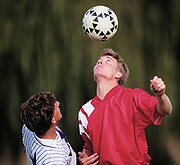
TUESDAY, Dec. 7 (HealthDay News) — Among high school athletes, girls who suffer concussions may have different symptoms than boys, a new study finds.
The findings suggest that boys are more likely to report amnesia and confusion/disorientation, whereas girls tend to report drowsiness and greater sensitivity to noise more often.
“The take-home message is that coaches, parents, athletic trainers, and physicians must be observant for all signs and symptoms of concussion, and should recognize that young male and female athletes may present with different symptoms,” said R. Dawn Comstock, an author of the study and an associate professor of pediatrics at the Ohio State University College of Medicine in Columbus.
The findings are slated to be presented Tuesday at the National Athletic Trainers’ Association’s (NATA) second Youth Sports Safety Summit in Washington, D.C.
More than 60,000 brain injuries occur among high school athletes every year, according to the U.S. Centers for Disease Control and Prevention. Although more males than females participate in sports, female athletes are more likely to suffer sports-related concussions, the researchers note. For instance, girls who play high school soccer suffer almost 40 percent more concussions than their male counterparts, according to NATA.
The findings suggest that girls who suffer concussions might sometimes go undiagnosed since symptoms such as drowsiness or sensitivity to noise “may be overlooked on sideline assessments or they may be attributed to other conditions,” Comstock said.
For the study, Comstock and her co-authors at the University of Virginia, Charlottesville, and the University of California, Santa Barbara, examined data from an Internet-based surveillance system for high school sports-related injuries. The researchers looked at concussions involved in interscholastic sports practice or competition in nine sports (boys’ football, soccer, basketball, wrestling and baseball and girls’ soccer, volleyball, basketball and softball) during the 2005-2006 and 2006-2007 school years at a representative sample of 100 high schools. During that time, 812 concussions (610 in boys and 202 in girls) were reported.
In addition to noting the prevalence of each reported symptom among males and females, the researchers compared the total number of symptoms, the time it took for symptoms to resolve, and how soon the athletes were allowed to return to play. Based on previous studies, the researchers thought that girls would report more concussion symptoms, would have to wait longer for symptoms to resolve, and would take longer to return to play. However, there was no gender difference in those three areas.
During the first year of the study, the surveillance system included only the primary concussion symptom for each athlete. In the second year, high school athletic trainers were able to record all the symptoms reported by the concussed athlete.
In both years, headache was the most commonly reported symptom and no difference was noted between the sexes. However, in year one, 13 percent of the males reported confusion/disorientation as their primary symptom versus 6 percent of the girls. Also in the first year, amnesia was the primary symptom of 9 percent of the males but only 3 percent of the females.
In the second year, amnesia and confusion/disorientation continued to be more common among males than females. In addition, 31 percent of the concussed females complained of drowsiness versus 20 percent of the males, and 14 percent of the females said they were sensitive to noise, compared with just 5 percent of the males.
Concussion researcher Gerard A. Gioia, chief of pediatric neuropsychology at Children’s National Medical Center in Washington, D.C., called the findings “relatively subtle” and “at best hypothesis-generating, meaning they are suggestive but in no way conclusive.”
Gioia said one of the study’s limitations is that the reporting system didn’t explain about how the injuries occurred. “The presence of increased amnesia and confusion, two early injury characteristics, in the males suggests that the injuries between the males and females may have been different,” he said.
Future studies will likely address this theory, said Comstock, now that the surveillance system has been expanded to include much more detailed information. Preliminary data suggest, for instance, that football players tend to get hit on the front of the head, while girls who play soccer or basketball often suffer a blow to the side of the head, she said.
The findings will also be published in the January issue of the Journal of Athletic Training.
More information
For more about concussion, visit the American Academy of Family Physicians.

